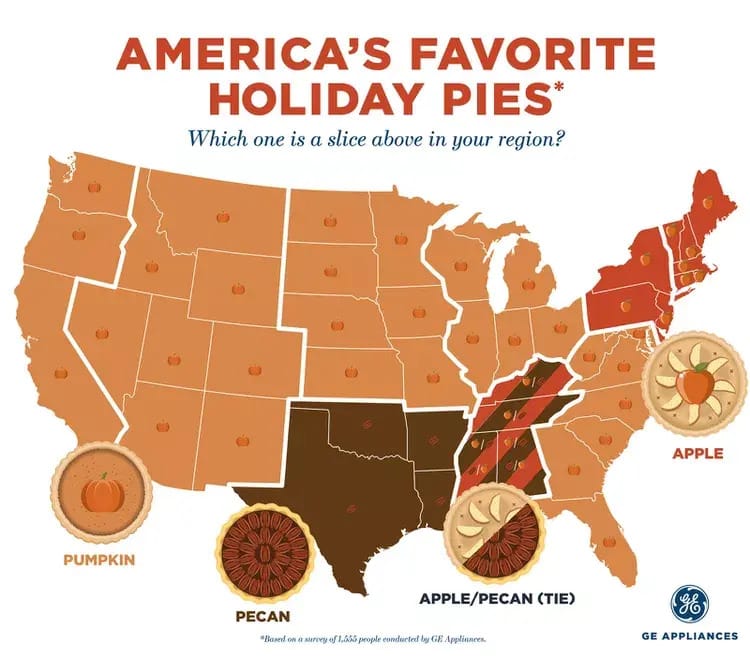
Happy Veterans Day! Thank you to all who served. — Dan
How the Civil War Decided What Pie You Eat on Thanksgiving
Later this month, Americans across the nation will celebrate Thanksgiving, most likely with a large, festive meal. There’s often turkey, stuffing, cranberry sauce, all sorts of salad, maybe macaroni and cheese, and for dessert, a pie. The types of pies can vary — sometimes there’s pumpkin pie, sometimes pecan, or sweet potato, or apple pie.
Which pie you get, though, may not just be random. In 2018, General Electric polled more than 1,500 Americans about what type of pie will be at their holiday table. As Food and Wine magazine reported, there were some regional patterns, as seen below.

Pumpkin pie is seemingly everywhere, except in the northeast, where apple pie is more popular, likely because apples are common in the region. And then there’s a swath of land in the south, spanning from Texas through Kentucky, where pumpkin, again, takes a back seat to other options — pecan and, to a lesser degree, apple, specifically.
The reason? Slavery, maybe.
On October 3, 1863, President Abraham Lincoln issued a proclamation declaring “the last Thursday of November next, as a day of Thanksgiving and Praise to our beneficent Father who dwelleth in the Heavens.” From then until 1941 — when Congress made Thanksgiving an official federal holiday — every president followed suit.
But Lincoln’s proclamation wasn’t well-received throughout the nation. The fall of 1863 was smack in the middle of the Civil War, and the South wasn’t keen on listening to the President of the country from which they were trying to secede. Even after the war ended in 1865, some southern states were slow to adopt the holiday and its traditions. As Atlas Obscura notes, “in Texas, Governor Oran Milo Roberts, a former Confederate army officer, refused to declare Thanksgiving a holiday as late as the 1880s. Some Southern governors would follow the annual presidential proclamations, but move the date of Thanksgiving to resist its message of national unity.”
Ultimately, the obvious appeal of Thanksgiving won out, and even Texas adopted the holiday. But an artifact of anti-Union sentiment remained on the menu — on the dessert table. Sarah Josepha Hale, a New England magazine editor who pushed for a national Thanksgiving holiday in the 1840s and through Lincoln’s proclamation, also shared pumpkin pie recipes in her publications, giving the dish its start toward holiday stardom. Some northern writers even described pumpkin pie as a symbol of the Union and — as it wasn’t cultivated by slaves — a food served to support the abolition of slavery. As historian Cindy Ott told USA Today, “there are these New England abolitionists writing saccharin-sweet stories about pumpkins. They very consciously saw these pumpkin farms in contrast to the immoral plantation economy and plantation farms in the South. They very specifically and explicitly compare those two landscapes.”
Many Southerners, therefore, refused to serve pumpkin pie at their dinners, even after the war ended. Before the century was out, sweet potato pie — already a popular southern food — found its way to the Thanksgiving table as a tasty alternative, and pecan pie made inroads in the region as well. And that tradition lasts today — according to Instacart’s 2024 data, via Food and Wine, “in the South. Shoppers in Georgia, Maryland, and North Carolina often pick sweet potato pie, whereas those in Texas and Mississippi favor pecan pie.” Pumpkin pie, still, rarely makes the list.
Visit Today’s Sponsor!
Smart Investors Don’t Guess. They Read The Daily Upside.
Markets are moving faster than ever — but so is the noise. Between clickbait headlines, empty hot takes, and AI-fueled hype cycles, it’s harder than ever to separate what matters from what doesn’t.
That’s where The Daily Upside comes in. Written by former bankers and veteran journalists, it brings sharp, actionable insights on markets, business, and the economy — the stories that actually move money and shape decisions.
That’s why over 1 million readers, including CFOs, portfolio managers, and executives from Wall Street to Main Street, rely on The Daily Upside to cut through the noise.
No fluff. No filler. Just clarity that helps you stay ahead.
More About Pumpkins
Today’s Bonus fact: Chances are, your pumpkin pie doesn’t contain actual pumpkins, at least not in the Jack-o-Lantern sense of the term “pumpkin.” Pumpkins are a cultivar of winter squash, and it turns out that other cultivars of winter squash tend to be sweeter and easier to grow. As The Kitchn explains, “some canned pumpkin purée is actually made from one or more types of winter squash, like butternut, Hubbard, Boston Marrow, and Golden Delicious,” and the use of actual pumpkins is rare. This isn’t false advertising, though, because the definition of “pumpkin” is kind of fluid. As Inc. explains, “The Food and Drug Administration, which is theoretically supposed to protect us from falsehoods in food labeling, has avoided the whole issue by not worrying too much about what constitutes a pumpkin and what doesn’t.” As a result, per Inc., “the only real pumpkin pies out there are made by die-hard cooks who buy fresh pumpkins and then steam them so they can remove and puree the flesh. Everyone else is eating squash pie instead.”
From the Archives: The Great Pumpkin Float: A regatta where people use giant pumpkins as boats.
Support Now I Know!
Now I Know is supported by readers like you. Yes, you! Many of my readers donate a few dollars a month to help Now I Know grow and thrive. And in exchange, they get an ad-free version!
Interested in supporting Now I Know? Click here!
And thanks! — Dan


